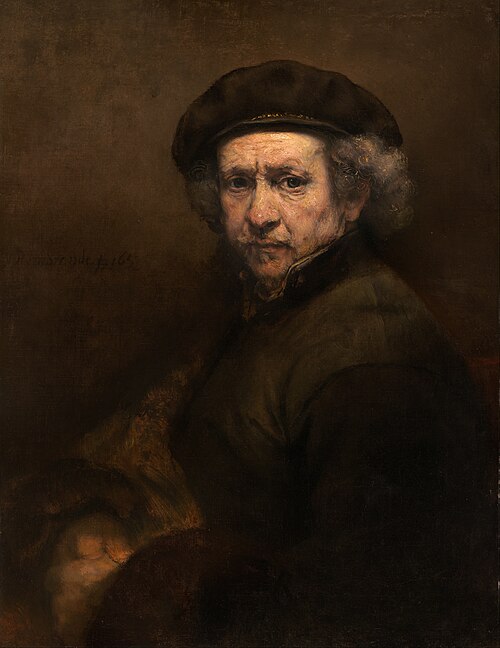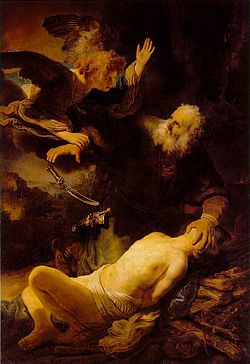Rembrandt Harmenszoon van Rijn, considered one of the greatest painters in the history of Western art, was born on July 15, 1606 in Leiden, in what is now the Netherlands. His father, a well-to-do miller, belonged to the Dutch Reformed Church. His mother was Catholic. Deeply influenced by religion, he lived during an era dominated by a series of European wars and religious strife arising out of the Reformation. He expressed his faith through both the subject matter and the empathetic and humanistic depth of his art.

Rembrandt’s biblical works span a wide range of subjects, including stories from Genesis; individuals from the Old Testament like Samson, Ruth, Saul, and David; and episodes from the life of Christ. He also frequently depicted the Passion, death, and resurrection of Jesus. Some of his notable works include The Raising of the Cross, Sacrifice of Isaac, Jacob Blessing the Sons of Joseph, Saint Matthew and the Angel and Bathsheba at Her Bath.
Rembrandt enrolled at the University of Leiden in 1620 but left the following year to follow his passion for art. He worked as an apprentice to Jacob van Swanenburg in Leiden for about three years before moving to Amsterdam in 1625 to complete his training with the leading painter of his day, Pieter Lastman. Later that year, he returned to Leiden and set up his own workshop in his parents’ house. He completed his first signed painting, The Stoning of Saint Stephen, that year and returned to biblical themes throughout his life. In 1629 an influential statesman, Constantijn Huygens, saw Rembrandt’s work and recommended it to Prince Frederik Hendrik. The subsequent commissions from the court of The Hague solidified his reputation as a most talented young artist.
At the end of 1631 Rembrandt moved to Amsterdam, where he would live for the remainder of his life. He enjoyed great success as a professional portrait artist while also developing his use of chiaroscuro (contrast of light and dark) in his painting. The Raising of Lazarus is an example of this technique, where light highlighting the figures contrasts with the darkness of the burial cave.
Rembrandt’s religious and biblically inspired art was an important part of his body of work. He often explored the human condition and the relationships between characters in the Bible, rather than just their actions. Approximately one-third of his legacy is devoted to the Bible.
His approach to biblical themes exhibited significant insight into the human psyche, portraying individuals as real people with depth and emotion. For instance, in Head of Christ he depicted Jesus as an average-looking Jewish young man without a halo. According to documentation displayed with this painting in the Philadelphia Museum of Art in 2011, “In posing an ethnographically correct model and using a human face to depict Jesus, Rembrandt overturned the entire history of Christian art, which had previously relied on rigidly copied prototypes for Christ.”

Later in life, amid personal tragedy and financial ruin, Rembrandt’s religious art grew even more intimate. One of his most powerful works, according to a number of art historians, is The Return of the Prodigal. H. W. Janson notes that it depicts “a moment stretching into eternity.” Kenneth Clark describes it as “a picture which those who have seen the original in St. Petersburg may be forgiven for claiming as the greatest picture ever painted.” Dutch priest Henri Nouwen, in his book The Return of the Prodigal Son (1991), wrote:
“Rembrandt is as much the elder son of the parable as he is the younger. When, during the last years of his life, he painted both sons in Return of the Prodigal Son, he had lived a life in which neither the lostness of the younger son nor the lostness of the elder son was alien to him. Both needed healing and forgiveness. Both needed to come home. Both needed the embrace of a forgiving father. But from the story itself, as well as from Rembrandt’s painting, it is clear that the hardest conversion to go through is the conversion of the one who stayed home.”
His last work, Simeon in the Temple, depicts the devout Simeon of Jerusalem, who had been promised by the Holy Spirit that he would not die until he saw the Messiah, holding the baby Jesus in the Temple. Rembrandt undoubtedly sensed his own approaching death as his brush strokes painted Simeon, who with the Christ child in his arms, knew his life would soon come to a close.
Rembrandt’s biblical works are not only religious in subject matter but also reflect his deep engagement with the Bible as a real book, rather than just a holy text. He was influenced by the stories and characters in the Bible, often using them to explore themes of redemption, human frailty, and divine grace. His works continue to be studied and appreciated for their profound spiritual and artistic significance.
